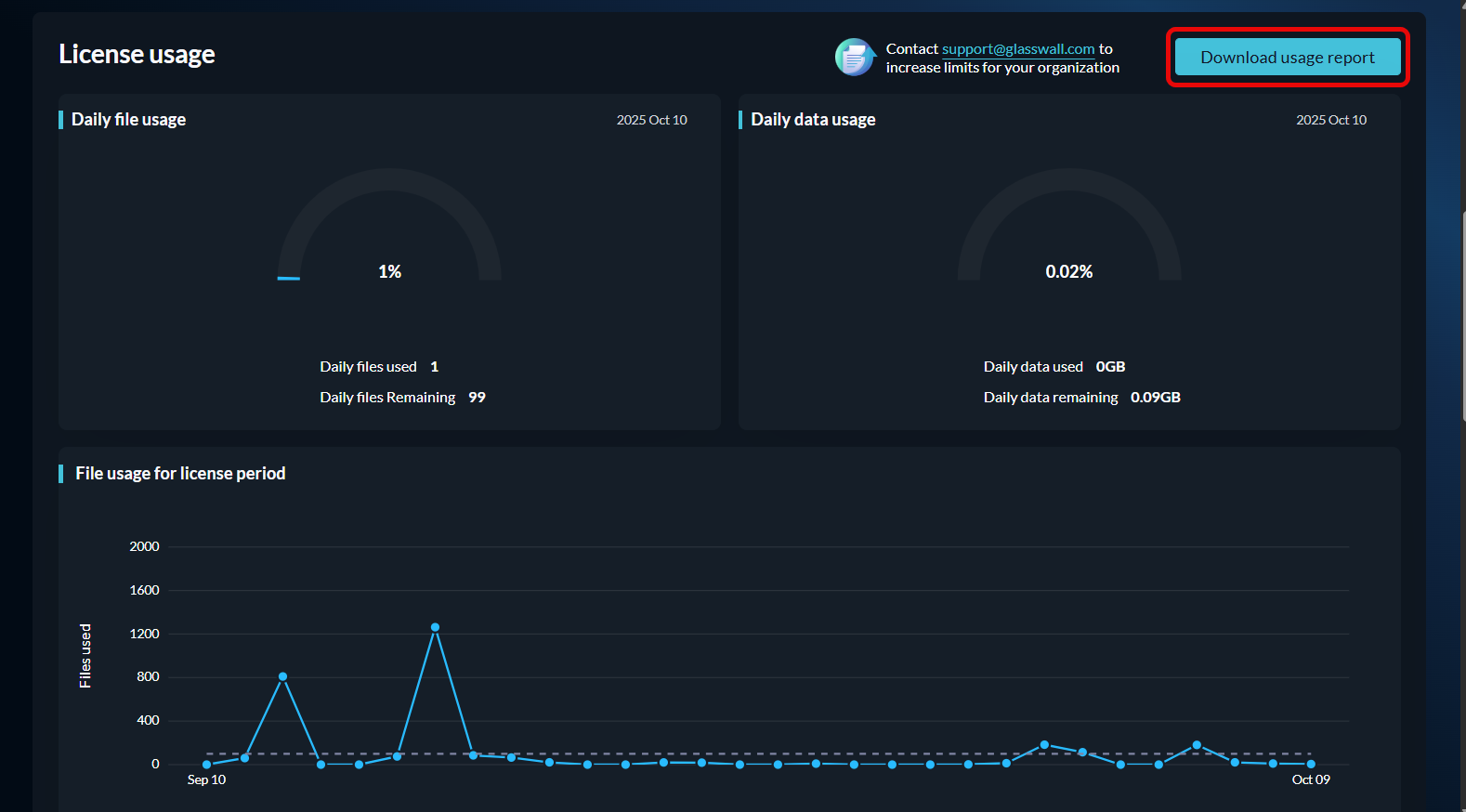Creating Usage Reports
Users have the ability to create a License Usage Report to show how much the system has been utilised. The report's primary purpose is to allow systems running in passive licensing mode to report to Glasswall how much of the license has been used. License usage data is aggregated daily into the report format, so recent activity may not appear immediately if the report is created soon after files are submitted to Halo.
Report contents
The report contains the following:
- The license ID the report is for
- The license name
- The limits for the license
- System usage split into daily buckets
- Each bucket includes the number of files and total size of files processed for that day
- Life cycle events related to the license (installation, deletion, etc.)
- Anomalies describing any issues the system encountered while tracking license usage
- The date the report was created
- The date the license was activated
The reportSignature is used to validate that the contents of the license have not been changed after being generated by the Halo system.
Information not captured
The License Usage Report does not include any sensitive or identifying data. Specifically, it does not capture:
- IP addresses
- Host or system details
- Metadata about file contents
- Any encrypted or user-specific information
This ensures that all license reporting remains secure, anonymised, and compliant with privacy and data protection standards.
Example usage report
{
"licenseReport": {
"licenseId": "1e6e8264-2aef-42ad-8fa3-f9f43bae5908",
"licenseName": "test_licensename:001",
"entitlementLimits": {
"haloProcessingDataLimit": "500G",
"haloProcessingFileLimit": "10000"
},
"usage": {
"2024-02-07": {
"dayFileSize": 301045177,
"dayFileCount": 210,
"anomalyCount": 0,
"anomalies": [
],
"lifeCycle": [
{
"detail": "License Installed",
"time": "2024-03-05T10:01:26.801Z"
}
]
},
"2024-02-08": {
"dayFileSize": 287259157,
"dayFileCount": 379,
"anomalyCount": 1,
"anomalies": [
{
"source": "license-monitor",
"time": "2024-02-21T15:06:00.457Z",
"message": "Tally Accumulator response could not be retrieved"
}
],
"lifeCycle": [
]
},
...
},
"created": "2024-03-06 11:22:13.970Z",
"activationDate": "2024-02-21T11:28:53Z"
},
"reportSignature": "eyJhbGciOiJIUzI1NiIsImI2NCI6ZmFsc2UsImtpZCI6ImNvbS5nbGFzc3dhbGwudXNhZ2UtcmVwb3J0LmhzMjU2LnYxIiwiY3JpdCI6WyJiNjQiXX0..PX-yzAbgSLCJDmW4Axf6sYvyIF-g_F8aiBQY96g8Fv8"
}
Creating a usage report with the API
Two new HTTP endpoints are available for programmatically downloading usage reports:
- GET
/api/v1/license-usage/activewill return a raw JSON response containing the usage report for the currently installed license. - GET
/api/v1/license-usage/{licenseId}will return the same type of response for a license that has been installed in the past. This works in conjunction with GET/api/v1/license-usagethat will return a list of past installed licenses
Creating a Usage Report via the Portal
You can also download a report for the currently installed license directly from the Halo Portal.
Only Admin users can perform this action from the System settings page. When downloaded, the report is provided as a .json file named using the license ID and the report’s creation date.
To download the usage report:
- Navigate to License management.
- Click Download usage report.

A .json file containing the report is downloaded to your machine.